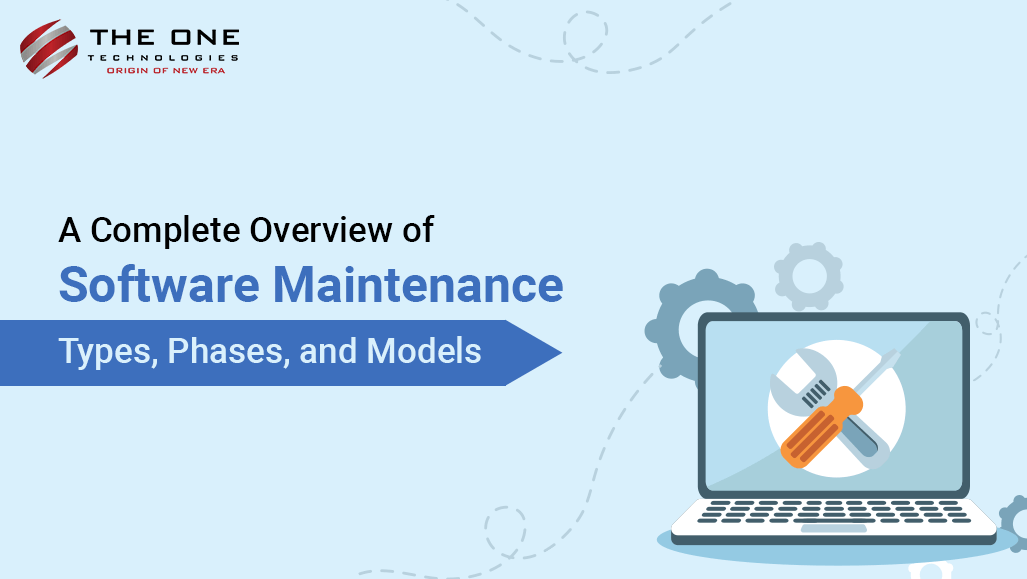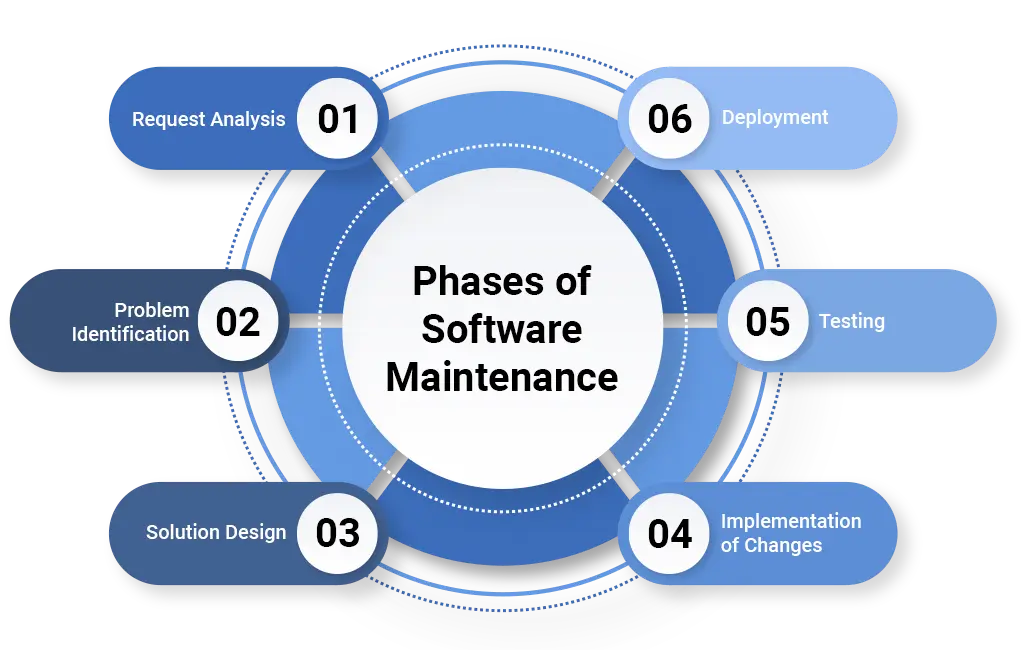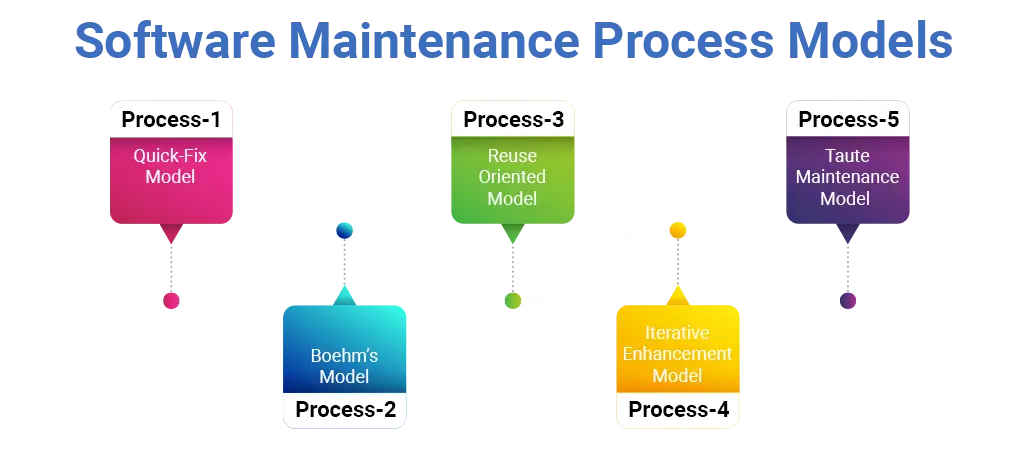Understanding Software Maintenance in Software Engineering

Table of Content
- What is Software Maintenance?
- Importance of Software Maintenance
- Types of Software Maintenance
- Phases of Software Maintenance
- Software Maintenance Process Models
- 5 Best Practices to Apply for Effective Software Maintenance
- Key Takeaway
- People Also Ask
What is Software Maintenance?
The process of running and enhancing software once it is created and released is referred to as software maintenance. It involves all measures that are taken to keep a software system up to date, operational, and consistent. With changing business needs and technological advancements. Software must be maintained if it is to be efficient, reliable, and safe throughout its lifetime.
Practically, software maintenance includes activities like patching security holes, adding new features. Adjusting to software or hardware environmental changes, and bug fixing. Application maintenance supports the fulfillment of user needs and delivery of expected results over a period of time is essential to maximize the durability and worth of software investments. Software maintenance is essentially the process of maintaining and developing software systems to support corporate activities.
Importance of Software Maintenance

In software development and business processes, the importance of software maintenance cannot be overemphasized. First and foremost, maintenance ensures that it remains functional and reliable in the long run. Software must evolve with the times in order to remain useful and applicable. Updating, enhancing, and correcting bugs are some of the maintenance activities that maintain the stability and responsiveness of the software to user requirements.
In addition, software maintenance is necessary to correct security vulnerabilities. Software security maintenance becomes more and more critical as cyber attacks keep evolving. Software needs to be updated and patched regularly. To be secure from possible breaches and vulnerabilities, to maintain sensitive information, and to retain users' confidence.
Plus, efficient software maintenance lowers overall costs and increases productivity. Organizations can limit downtime, reduce operational disruption, and maximize resource utilization. By actively maintaining and optimizing software performance. This will provide maximum return on investment in software development while also enhancing productivity. Ultimately, software maintenance is an essential strategic imperative for companies that want to leverage technology effectively and sustainably.
Types of Software Maintenance
Corrective Software Maintenance
This activity of detecting and fixing faults, bugs, or issues that are discovered in software that is being used continuously. This type of maintenance repairs problems that have been reported by users. Or detected by testing and monitoring, to return the product to operating as designed. Software operation reliability is maintained, and downtime is reduced with corrective maintenance.
Key Activities:
- Recognizing and fixing errors or inaccuracies that have been reported.
- Analyzing the root cause of errors.
- Creating and putting into use patches or fixes.
- Testing to confirm whether corrective measures are working.
- Deploying updates into operational settings.
Adaptive Software Maintenance
It is the process of developing software to exploit changes in the environment. Like operating system upgrades, hardware enhancements, or new regulatory requirements. Such maintenance makes the program continue to operate. And be compatible with changing commercial and technical surroundings. Adaptive maintenance must be undertaken in order to improve the lifetime and utility of the software.
Key Activities:
- Evaluating how the software is affected by changes in the environment.
- Adjusting code or configurations to meet new specifications.
- Validating compatibility and performance through testing.
- Documentation is being updated to reflect changes.
- Implementing modifications in operational settings.
Perfective Software Maintenance
Improving the software's performance, usability, or efficiency is the aim of perfective maintenance. Without altering its core features. The objective of this type of maintenance is to enhance software features. Based on feedback from users, advances in technology, or evolving business needs.
Enhancing user pleasure and program quality are two benefits of perfective maintenance.
Key Activities:
- Examining requests for enhancements and feedback from customers.
- Identifying where features or performance might be improved.
- Rewriting code to make it more scalable and maintainable.
- Implementing new features or upgrades into practice.
- Testing modifications to make sure they adhere to quality requirements.
- Preventive Software Maintenance
Problem detection and problem solving before they are faults or issues is the objective of preventive maintenance. By implementing policies to enhance software stability and robustness. Such maintenance seeks to reduce the likelihood of future malfunctions or degradation in performance. By minimizing risks and improving program reliability overall, preventive maintenance benefits.
Key Activities:
- To find possible vulnerabilities, do code reviews and analysis.
- Applying updates and security patches.
- Maximizing the use of available resources to avoid performance complexities.
- Performing recurring health checks and system audits.
- Putting backup and disaster recovery plans into action.
Phases of Software Maintenance

To guarantee the continued usage, stability, and functionality of software programs, software maintenance is an essential procedure. It requires several clearly defined stages to manage and improve software systems. The primary stages of software maintenance are listed below:
Phase 1: Request Analysis
During the request analysis stage, the maintenance team receives user requests or stakeholder requests for change, update, or fixing. This stage encompasses:
- Gathering Requirements: determining the type and scope of the suggested modification or enhancement.
- Assessing Impact: evaluating how the proposed modification would affect the existing software system.
- Estimating Resources: Determining how much time, effort, and resources are required for the maintenance work.
Phase 2: Problem Identification
In this stage, emphasis is placed on determining the precise problems or issues in the software. Activities are:
- Issue Investigation: Carrying out extensive analysis and testing to identify the actual cause of the problem.
- Documentation: Recording identified issues along with their effects on the functionality of the software.
Phase 3: Solution Design
After the issues are determined, the subsequent step is to create suitable solutions. This stage entails:
- Brainstorming Solutions: Working together to consider various methods of solving the issues identified.
- Architectural Design: Designing the technical implementation specifics of the solutions proposed.
- Prototyping: Creating prototypes or mock-ups to see the proposed changes.
Phase 4: Implementation of Changes
Step of Implementation: The suggested modifications are included into the software system during this step. Major activities are:
- Coding and Development: Developing code to implement the accepted changes in the current software.
- Version Control: Version control systems are used to manage and track changes.
- Code Review: Peer review to verify code quality and coding standards.
Phase 5: Testing
To verify the modifications made and whether they meet the relevant requirements, testing is required. This stage includes:
- Unit Testing: Testing individual modules or components to ensure their functionality.
- Integration Testing: Verifying that components interact as intended requires testing the entire system.
- Regression Testing: Confirming unforeseen consequences for existing features.
Phase 6: Deployment
The deployment phase marks the rollout of the updated software into production. This includes:
- Release Management: Planning and coordinating the deployment schedule.
- User Training: Conducting training sessions for users to adapt to the changes.
- Post-Deployment Support: Providing support and monitoring for any issues post-deployment.
Software Maintenance Process Models

Quick-Fix Model
This model is set apart by its quick response to software problems, seeking to quickly address key issues without requiring a great deal of thought or preparation. For urgent bug repairs and other issues that need to be addressed right away to restore system functionality, this model is perfect. It might, however, be devoid of long-term planning and documentation, putting more of an emphasis on temporary fixes to reduce interruptions.
Boehm's Model
One of the commonly used software maintenance models, Boehm's emphasizes organized procedures and documentation, integrating disciplined software engineering practices into the maintenance process. This paradigm promotes thorough planning, risk management, and methodical analysis to guarantee maintenance operations. It works well with large-scale software systems where successful maintenance depends on traceability and controlled operations.
Reuse-Oriented Model
Reusing software is encouraged by the Reuse-Oriented Model as a means of effective maintenance. This concept seeks to lessen labor and redundancy in maintenance duties by keeping a repository of reusable components. To meet maintenance requirements and promote economic maintenance procedures, it entails choosing and modifying pre-existing components.
Iterative Enhancement Model
This amazing software maintenance model concentrates on continuously providing feedback and adapting software systems to make iterative and incremental changes. It allows for the gradual rollout of improvements in response to changing customer and market demands. This approach works effectively in dynamic settings where the software needs to change often to stay competitive and meet shifting business needs.
Taute Maintenance Model
Lastly, the Taute Maintenance Model places a strong emphasis on software maintenance's strategic resource allocation and prioritization. This model makes sure that resources are used maximizes maintenance efforts by assigning resources according to job criticality and business impact. Performance metrics are used to guide continuing improvements and decision-making by gauging the maintenance actions.
5 Best Practices to Apply for Effective Software Maintenance
Documentation Review and Management
Thorough documentation is necessary for program upkeep. It offers an extensive reference for comprehending the functioning, design choices, and system architecture. Documents must be properly arranged and versioned so that the team can quickly access them. This is known as proper documentation management. Troubleshooting, debugging, and future developments are streamlined by clear and current documentation, which reduces errors and saves time when doing maintenance duties.
Implement Version Control Systems
Git and other version controls allow teams to effectively manage source code changes. With branching, tagging, and merging features, developers can collaborate easily, monitor changes to the code, and roll back to previous versions when needed. This helps maintain the cleanliness of the code and allows for effective collaboration.
Process Automation
Software maintenance activities are made more efficient by automating routine tasks. Like configuration management, testing, and deployment. Automating repetitive tasks through the use of tools like Ansible, Jenkins, or Puppet lowers error rates from manual interventions and enables resources to be applied to more complicated problems. Automation increases process efficiency and uniformity in software maintenance.
Investing in Quality Assurance
Software maintenance is highly dependent on quality assurance (QA) to discover and correct bugs, vulnerabilities, and usability issues. Implementing comprehensive quality assurance practices. Including security, performance, and functional testing, ensures that software updates meet requirements for quality. And offer a seamless user experience.
Implement CI/CD
The build, test, and deployment stages of software development is automated by CI/CD processes. Teams can reliably and quickly deliver updates to production by automating deployment pipelines and merging code changes on a regular basis. With iterative development cycles, continuous integration and delivery (CI/CD) reduces the possibility of introducing faults into the production environment and promotes continuous improvement.
Key Takeaway
By reading this blog, you should have known the importance of software maintenance in engineering. Software maintenance is vital to ensuring the functionality and effectiveness of software applications over time. With knowledge of the above-discussed concepts. And applying appropriate methodologies, organizations can improve the performance of software. Improve user satisfaction, and respond to changing business needs of technology.
Software maintenance can be difficult, but with a dash of humor and a pinch of imagination, every step is an exciting ride in the realm of coding and troubleshooting. To ensure that this ride is smooth, you can outsource our off-the-wall software maintenance services. And let us take care of your requirements and solutions that are designed to maximize your software's performance and lifespan.
People Also Ask
Q1. What is software maintenance and why is it important?
Once the software is released, it must be changed and modified to maintain its functionality, security, and reliability. This process is referred to as software maintenance. It is required because it fixes errors, accommodates changing conditions, and enhances system performance over time.
Q2. How do you prioritize software maintenance tasks?
We prioritize software maintenance tasks based on factors such as:
- Impact on business operations.
- Degree of difficulty.
- Feedback and recommendations from customers.
- System criticality that is impacted.
Q3. What methodologies and tools do you use for software maintenance?
Agile and DevOps are two industry-standard approaches that we use at The One Technologies for effective software maintenance. For problem tracking, version control, testing, and deployment, we also make use of cutting-edge tools and technology.
Q4. How do you ensure the security of software during maintenance?
Security is a top priority during software maintenance. We implement best practices such as:
- Regular security audits and vulnerability assessments.
- Applying security patches and updates promptly.
- Following secure coding practices.
- Implementing access controls and encryption where necessary.
Q5. How can I request software maintenance services from your team?
Just send us a request for our software support and maintenance by contacting us via our site. Or reaching our support staff at info@theonetechnologies.com. We will review your needs, negotiate service terms, and deliver a tailored plan for meeting your software maintenance requirements in the most effective way.










